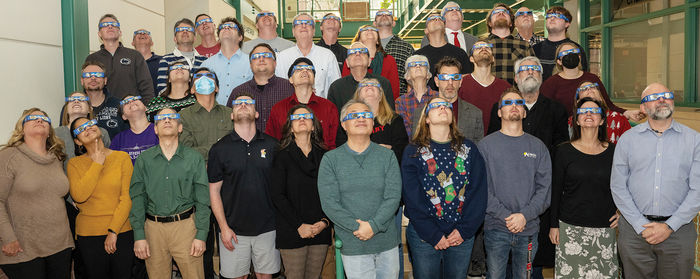Total solar eclipse will draw big crowds to Erie, Behrend
Penn State Behrend has been preparing for Erie’s big moment in the sun— or rather lack of it—since the last total solar eclipse in the United States in 2017. At that time, the path of totality— where the moon aligns perfectly with the sun to temporarily block out all light—was in the central part of the country, several states away from Pennsylvania.
But on April 8, Erie—and Behrend— will be in the path of totality, a oncein- a-lifetime event that is expected to draw as many as 250,000 visitors to the area. Northwestern Pennsylvania is the only region of the state that will experience totality.
After seeing the crowds and enthusiasm that the partial eclipse elicited in 2017, Tracy Halmi, associate teaching professor of chemistry and outreach coordinator for the School of Science, realized that Behrend needed to start planning for 2024 early on.
Safety was Halmi’s first concern, so she championed the effort to secure more than 55,000 eclipse glasses, enough not only for Behrend students, staff, and faculty, but for every K-12 public-school student in Erie, Crawford, and Warren counties, thanks to sponsors Greg Yahn and John and Louise Mangus. The glasses, along with special eclipse curriculum for K-12 teachers, will be distributed through the IU5, Northwest (Pennsylvania) Tri-County Intermediate Unit.
On the day of the eclipse, Behrend’s resident experts—Dr. Darren Williams, professor of astronomy and astrophysics, and Jim Gavio, director of Yahn Planetarium—will provide commentary during a live-streamed event at Junker Center. Public viewing sites will be available across campus.
What to Expect
The eclipse will begin in the South Pacific Ocean and cross Mexico before passing through the United States, arcing from Texas to Maine. In Erie, the eclipse will appear in the southwest sky at about 45 degrees. The partial phase will begin at 2:02 p.m. with totality (complete blacking out of the sun) from 3:16 to 3:20 p.m. During totality, there will be dusk-like darkness. Street lights will turn on. Birds and animals will think it’s nighttime.
What to Know
You should not watch the partial phases of the eclipse without eclipse glasses or solar filters. The only time it is safe to observe without glasses is during totality, which will be 3 minutes and 41 seconds long.
For more information, visit behrend.psu.edu/eclipse. Check out tiktok.com/@psbehrend to see several short videos about the eclipse event.
Behrend to Record Momentous Event
Penn State Behrend will be one of thirty-five teams along the eclipse path that will be participating in the Citizen Continental- America Telescopic Eclipse (CATE) 2024 project, which will provide next-generation polarized observations during the eclipse using a network of telescopes that will provide sixty continuous minutes of totality images. The experiment is funded by the National Science Foundation and NASA. Participating teams will be provided with a telescope, camera, laptop, various other observing equipment, and educational materials. Learn more at nso.edu/citizen-cate.
